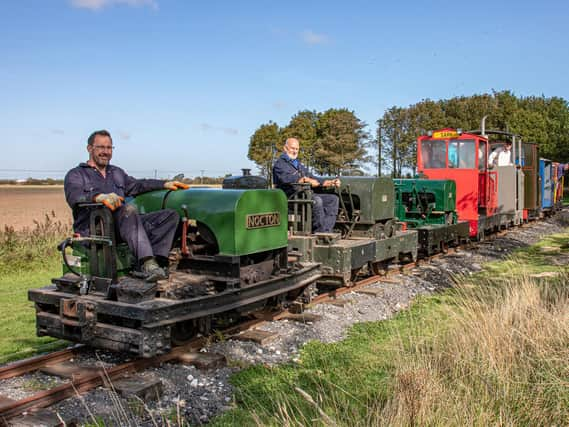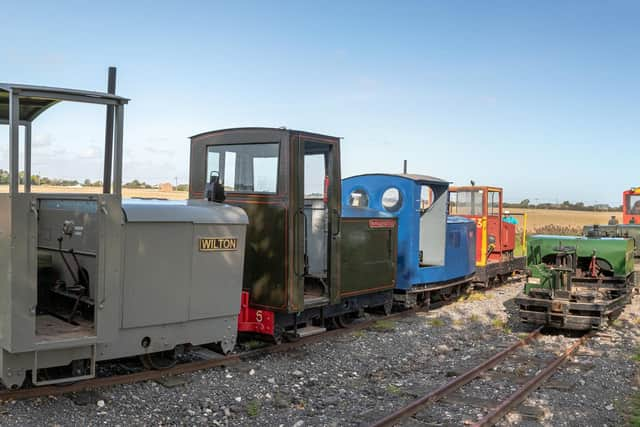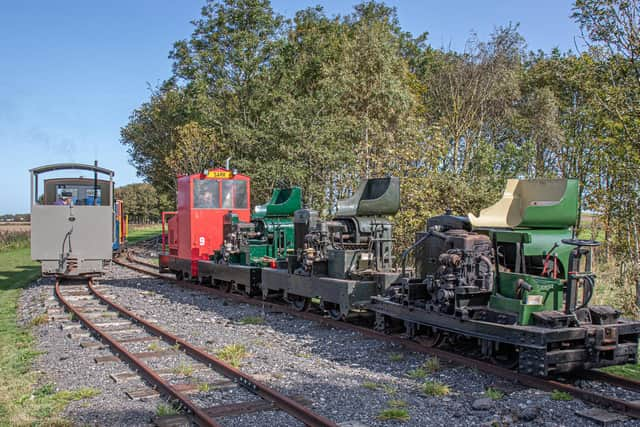Convoy: Eight historic locos mark line's 60th anniversary


The Lincolnshire Coast Light Railway – the world’s first heritage line to be built by enthusiasts - operated its Motor Rail ‘Simplex’ diesel locomotives together on the track in the Skegness Water Leisure Park, beside Skegness Airfield.
Because of the coronavirus restrictions which have kept the line closed during its anniversary year, only those working volunteers on duty could participate.
Advertisement
Advertisement
However, the project has seen the completion of a 30-year restoration to the working order the “Skeg Simplex” which once worked at the resort’s brickworks and in 1953, survived inundation by seawater and sand in the catastrophic East Coast floods, which killed 307 people in England, a further 224 at sea and a total of 2,551 across four countries.


It was recovered, emptied of sea water and sand, restarted and put to work helping to strengthen sea defences in the Mablethorpe area.
The locomotive was built as a straight-frame ‘Simplex’ by Motor Rail in 1947, as works number 9264, for a Mablethorpe firm of civil engineers, was then sold to the town’s brickworks and resold to Skegness Brick Works.
It was acquired in poor condition by a member of the LCLR’s Historic Vehicles Trust, who donated it to the charity.
Advertisement
Advertisement
The oldest locomotive in the cavalcade was centenarian Nocton, a bow-frame ‘Simplex’ built by Motor Rail at their Bedford factory in 1920 as works number 1935.


It ran on the Nocton Estates Railway in the Lincolnshire Fens, hauling train-loads of potatoes for Smiths Crisps and sugar beet for the Bardney sugar factory, before purchase by the Lincolnshire Coast Light Railway 50 years ago.
In recent years, the condition of its original radiator had made it difficult to operate and all the tubes and seals in it had painstakingly been replaced in recent months by the volunteers to return it to working order.
Despite the poor condition of its radiator, Nocton had run at the Tracks to the Trenches event on the Apedale Railway in Staffordshire, to commemorate the role of narrow gauge railways in World War One and the bravery and sacrifice of the Allied soldiers who had operated them under fire.
Advertisement
Advertisement
Also in the line up was the Lincolnshire Coast Light Railway’s original locomotive from the opening day on August 27, 1960, the line’s No. 1, Paul, which was one of two locos to operate a Royal Train for HRH The Princess Royal (Princess Anne) when she visited the railway in 2017.
It was built by Motor Rail as a bow-frame ‘Simplex’, works number 3995, in 1926.
Motor Rail’s “’Simplex’ locomotives were originally produced for the British War Department Light Railways in World War One, to move men and munitions and everything needed to
fight a war, to the front line trenches.
The design proved so robust and reliable that production continued in modified form through to the 1960s, in 20, 40 and 60 hp versions for different gauges keeping the products of much of Britain’s factories, farms, quarries and military depots moving.
Advertisement
Advertisement
Many were exported and some are still at work around the world.
Other locos in the LCLR’s cavalcade included Wilton, a straight-frame ‘Simplex’, works number 7481 of 1940, supplied to Humberston Brickworks, before purchase by the Lincolnshire Coast Light Railway for use on its original site at Humberston, south of Cleethorpes;
straight-frame ‘Simplex’ works number 8622 of 1941, supplied to the War Department but never used by them;
a further straight frame ‘Simplex’ fitted with a body made by the LCLR, works number 8874 of 1944, also for the WD and named Major J A Robins RE in honour of
the late president of the LCLR’s charitable trust.
Advertisement
Advertisement
The cavalcade also included two privately owned 40 hp straight frame ‘Simplexes’, which are fitted with air cooled Duetz F3 912 engines and electric starts: works number 8738, named T3, which previously worked at Sinclair Horticulture in Penicuik, Midlothian, Scotland and Sark, works number 8825 of 1943, acquired from Bolton Fell Peat Works at
Heathersgill, Cumbria.
Railway spokesman John Chappell said: “It was a truly remarkable sight to see these eight locomotives working together on our track in the Skegness Water Leisure Park; a tribute to
the hard work, tenacity and skill of our volunteers.
"They have worked under frequently difficult conditions during and before the pandemic, to make it possible to bring our entire collection to working order”.
* Earlier in September, the Lincolnshire Coast Light Railway Historic Vehicles Trust announced that it has received confirmation of a significant £10,000 grant awarded through The National Lottery Heritage Fund’s Heritage Emergency Fund, which aims to help heritage organisations survive and recover from the impact of the COVID-19 pandemic.
Advertisement
Advertisement
The grant, will cover installation of electricity, water and sewage to new hygiene facilities enabling volunteers to keep themselves safe with adequate hand washing and hygiene facilities and to safely sanitise rolling stock for passengers.